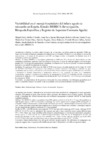Mostrar o rexistro simple do ítem
Variabilidad en el manejo hospitalario del infarto agudo de miocardio en España. Estudio IBERICA (Investigación, Búsqueda Específica y Registro de Isquemia Coronaria Aguda)
| dc.contributor.author | Fiol, Miquel | |
| dc.contributor.author | Cabadés, Adolfo | |
| dc.contributor.author | Sala, Joan | |
| dc.contributor.author | Marrugat, Jaume | |
| dc.contributor.author | Elosua, Roberto | |
| dc.contributor.author | Vega, Gemma | |
| dc.contributor.author | Tormo, María José | |
| dc.contributor.author | Segura Fragoso, Antonio | |
| dc.contributor.author | Aldasoro, Elena | |
| dc.contributor.author | Moreno-Iribas, Concepción | |
| dc.contributor.author | Muñiz, Javier | |
| dc.contributor.author | Hurtado-de-Saracho, Iraida | |
| dc.contributor.author | García, José | |
| dc.date.accessioned | 2015-11-19T10:40:08Z | |
| dc.date.available | 2015-11-19T10:40:08Z | |
| dc.date.issued | 2001 | |
| dc.identifier.citation | Fiol M, Cabadés A, Sala J, Marrugat, Elosua R, Vega G, et al. Variabilidad en el manejo hospitalario del infarto agudo de miocardio en España. Estudio IBERICA (Investigación, Búsqueda Específica y Registro de Isquemia Coronaria Aguda). Rev esp Cardiol. 2011;54(4):443-452 | es_ES |
| dc.identifier.uri | http://hdl.handle.net/2183/15572 | |
| dc.description.abstract | [Resumen] Introducción y objetivos. Los datos sobre el manejo de los pacientes con infarto agudo de miocardio (IAM) que llegan a un hospital en España no garantizan la exhaustividad en el registro. El objetivo de este trabajo es conocer las características y el manejo de los pacientes con IAM que llegan a todos los hospitales de distintas áreas de 8 comunidades autónomas españolas. Métodos. El estudio IBERICA es un registro poblacional de IAM entre 25 y 74 años de edad realizado en ocho comunidades autónomas españolas. Para este trabajo se incluyeron los casos de IAM que llegaron vivos al hospital durante 1997. Se recogen las características, tratamiento y evolución a los 28 días del episodio. Se realizó un análisis descriptivo y se calculó el coeficiente de variación. Resultados. Se registraron 4.041 casos de IAM: el 79,9% eran varones y la edad media fue de 61,1 años. El 10,9% (IC del 95%: 9,9-11,9%) no ingresaron en una unidad de cuidados intensivos cardiológicos, existiendo una gran variabilidad entre las zonas (coeficiente de variación del 53%). Existe también una gran variabilidad en la realización e indicación de técnicas diagnósticas y terapéuticas invasivas y no invasivas, así como en el tratamiento farmacológico empleado: únicamente la utilización de antiagregantes (91,5%) Y trombólisis (41,8%) presenta un coeficiente de variación < 10%. La letilidad a los 28 días fue del 16,2% (IC del 95%: 15,1-17,4%) con un coeficiente de variación del 20,6%. Conclusión. Las características de los pacientes varían entre las zonas estudiadas. Las diferencias geográficas en el manejo y pronóstico sugieren que puede existir desigualdades en la atención al enfermo con IAM en España. | es_ES |
| dc.description.abstract | [Abstract] Introduction and objective. Although some in-hospital studies have described the management of acute myocardial infarction (MI) patients in Spain, none has been able to guarantee the exhaustiveness of patient registry. This study sought to determine the clinical characteristics and in-hospital management of patients with MI in eight Spanish population registries. Methods. The IBERICA study is a population-based MI registry carried out in the 25 to 74 year-old population, in eight Spanish regions in 1997. A standardized methology was used to register and investigate all MI arriving alive to a hospital. Clinical characteristics, cardiovascular risk factors prevalence, pharmacological treatment, invasive and non- invasive procedures performed and complications at 28 days of evolution were recorded. A descriptive analysis was performed and the variation coefficient (VC) was calculated. Results. In 1997, 4,041 MI patients were registered, 79.9% were men with a mean age of 61.1 years. Although 10.9% (95% CI: 9.9-11.9%) were not admitted to the coronary care unit, a large variability existed among different areas (VC = 53%). There was a high variability in the utilization and performance of non-invasive and invasive procedures among regions, as well as in the use of pharmacological treatment. Only the use of antiaggregants (91.5%) and thrombolytic theraphy (41.8%) showed a low variability (VC < 10%). Twenty-eight day mortality was 16.2% (95% el: 15.1-17.4%) with a high variability being observed among the different regions (VC = 20.6%). Conclusion. Patient characteristics vary among the different Spanish regions. The differences in management and prognosis suggest a lack of equality in the health care provided to MI patients in the different regions in Spain. | es_ES |
| dc.language.iso | spa | es_ES |
| dc.publisher | Elsevier | es_ES |
| dc.relation.uri | http://dx.doi.org/10.1016/S0300-8932(01)76332-4 | es_ES |
| dc.rights | Creative Commons Licence | es_ES |
| dc.rights | Reconocimiento-NoComercial-SinObraDerivada 4.0 Internacional | |
| dc.rights.uri | http://creativecommons.org/licenses/by-nc-nd/4.0/ | |
| dc.subject | Epidemiología | es_ES |
| dc.subject | Fármacos | es_ES |
| dc.subject | Infarto de miocardio | es_ES |
| dc.subject | Registros | es_ES |
| dc.subject | Drugs | es_ES |
| dc.subject | Epidemiology | es_ES |
| dc.subject | Myocardial infarction | es_ES |
| dc.subject | Registry | es_ES |
| dc.title | Variabilidad en el manejo hospitalario del infarto agudo de miocardio en España. Estudio IBERICA (Investigación, Búsqueda Específica y Registro de Isquemia Coronaria Aguda) | es_ES |
| dc.type | info:eu-repo/semantics/article | es_ES |
| dc.rights.access | info:eu-repo/semantics/openAccess | es_ES |
Ficheiros no ítem
Este ítem aparece na(s) seguinte(s) colección(s)
-
GI- GRINCAR - Artigos [216]






